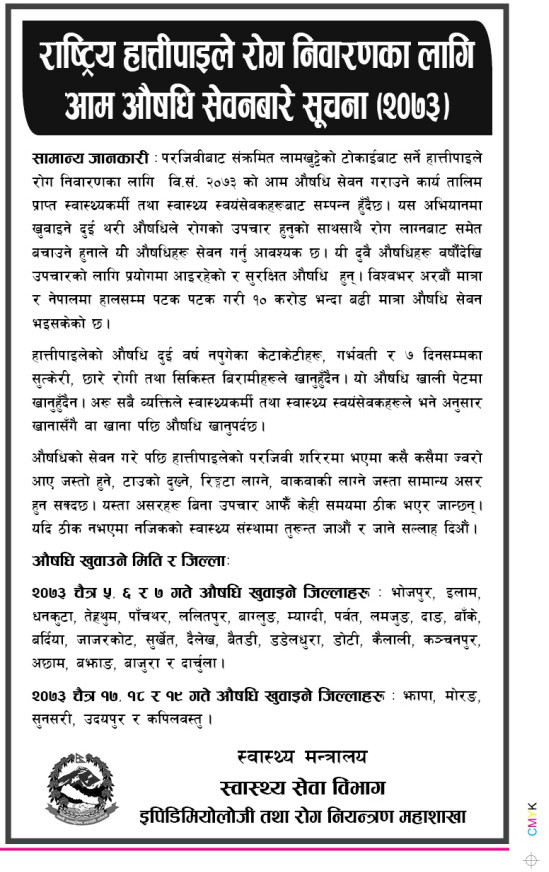The disease has been detected in different topographical areas ranging in
altitude from 300 feet above sea level in the plain terai ecological zone to 5,800 feet above sea level in high hill areas. Comparatively, more LF cases are seen in the terai than in the hills, but valleys and river basin areas of hilly districts have also high disease burden. The disease is more prevalent in the rural areas of the country, predominantly affecting the poorer sector of the community. Wuchereria bancrofti is the only recorded parasite in Nepal and the mosquito, Culex.quinquefasciatus, an efficient vector of the disease has been recorded in all the endemic areas of the country.By this fiscal year 2071/72 (2014/2015), MDA has been stopped (phased out) in 20 districts, post MDA surveillance has been initiated in at least five districts and morbidity management has been initiated in selected districts and high endemic areas. All endemic districts will complete the recommended six rounds of MDA by 2018. The LF elimination programme has also indirectly contributed to strengthening of health system through training and capacity building activities. Between these periods of twelve years, various surveys have been carried out including mapping, base line surveys, follow up surveys, post MDA coverage survey and transmission assessment surveys (TAS). TAS done in 21 districts has revealed that the prevalence of LF infection has significantly reduced and contributed in preventing disabilities and sufferings due to LF. Over the period of last 12 years, more than 90 million doses has been administrated to at risk population.
- People of Nepal no longer suffer from LF
- To eliminate LF as a public health problem by 2020;
- To interrupt the transmission of lymphatic filariasis;
- To reduce and prevent morbidity;
- To provide de‐worming benefit through use of Albendazole to endemic community especially to the children; and
- To reduce mosquito vectors through application of suitable and available vector control measures (Integrated Vector Management).
- Interruption of transmission by yearly Mass Drug Administration using two drug regimens (DiethylcarbamazineCitrate and Albendazole) for six years.
- Morbidity management by self‐care and with supports using intensive but simple, effective and local hygienic techniques.
Target
- To scale up MDA to all LF endemic districts by 2014
- Achieve <1% prevalence (microfilaraemia rate) in all endemic districts after 6 years of MDA by 2018
- Advocacy, IEC/BCC activities.
- Coordination
- Monitoring and supervision
- Training of health workers
- Volunteers orientation
- Media mobilization and advertisement
- Coordination and collaboration with all stakeholders
- School health programme‐interactions in schools
- Morbidity management‐ hydrocele surgery camps
- care training and material distribution to lymphedema (elephantiasis) cases.



